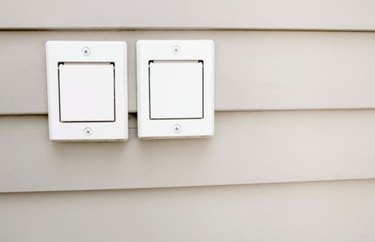
Covering the walls of buildings with additional material or cladding is often done for decorative or protective reasons. Builders can choose from a variety of options to clad buildings. Different methods produce different effects to appeal to various tastes. Builders must choose a material suitable for the climate if the cladding is for external walls.
Planking
Video of the Day
Plank cladding involves mounting the planks onto timber battens that have been fastened to the building. It is best to mount the planks horizontally so that moisture flows downward and is therefore less likely to soak through to the walls. In sections where the building isn't weather-tight, you will need to place a membrane between the battens and the building. Builders will also keep a gap of around one inch behind the cladding for air to circulate and to make sure moisture does not become trapped. Planking has customarily been done with timber, but uPVC also can be used. The advantage to using uPVC is that it requires less maintenance.
Video of the Day
Plasterboard
Plasterboard is generally used to clad internal walls. It is a pliable material that can be easily cut with a craft knife and helps to give internal walls a smooth surface which is easy to plaster and then paint. Plasterboard should be cut a half-inch shorter than the wall and should be nailed onto the wall framework. It is important to make sure that the smooth side of the plasterboard is facing out before you nail it in place. Jointing tape should be placed over the joints of plasterboard to give a smooth finish.
Brick
Brick slips or brick cladding is mostly a decorative method of cladding. Brick slips are a thinner version of bricks and are attached to a substrate using an adhesive rather than mortar, which is what would be used with traditional bricks. Some manufacturers produce panel or locking systems of brick slips, which can be installed quicker than using adhesive. Brick slips are not only used to clad walls but are also used to clad fireplaces.
Metal
Metal cladding is a method used on industrial buildings but is a choice for private dwellings, too. The most common types of metals used as cladding are steel and aluminum. Aluminum is the most corrosion resistant. Metal cladding can be attached in several ways, such as profiled or composite metal cladding. This type of metal cladding like planking, is most often laid horizontally in panels onto a building wall. The panels are attached via vertical subframes. The durability of metal cladding depends on the type of metals used, what type of exposure the building will have and the effectiveness of corrosion-protection system.
Stone
Natural stone is used for its durability. It is also a very attractive method of cladding as stone comes in a variety of colors, textures and shapes. Real stone can be bonded to the majority of buildings, from timber-faced buildings to brick buildings. Stone cladding can be applied in a panel-like fashion or in a more random pattern. Stone cladding is not only durable and attractive, but also serves and a good insulation material.